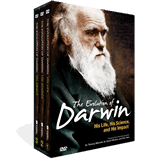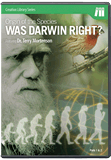
A Second Bombshell for Replacing Darwin?
Darwin’s finches further confirm predictions of landmark creationist book
At-a-Glance
- For decades, Darwin’s finches on the Galápagos Islands have been Exhibit A for evolution in real time.
- Recent observations documented the formation of a new species at rates much faster than predicted by evolution—but exactly in line with predictions that I published in Replacing Darwin.
- The manner in which this new species formed is also exactly in line with predictions that I published in Replacing Darwin.
- Together, these two results demonstrate that creation science is working—which is the gold standard by which scientific explanations are evaluated.
Five months ago, I published a book, Replacing Darwin: The New Origin of Species, in which I argued for a revolutionary thesis. I claimed that the progress of science over the last 150 years has not only rebutted Darwin’s central arguments for evolution; it has also replaced them with an entirely different scientific explanation for the origin of species. Recent research1 in the Galápagos Islands on Darwin’s finches—the modern poster child for evolution—has confirmed this wild pronouncement in at least two ways.
In my previous article, I briefly reviewed the history of these finches and explained the first way in which recent research on them supports my thesis. I also discussed why testable predictions are so foundational, not only to science, but to the long history of the origins debate. In a nutshell, explanations that make testable, falsifiable predictions are considered part of science; those that don’t are dismissed to the realm of pseudoscience. Replacing Darwin contains several falsifiable predictions, which are slowly being tested. In the first article, I evaluated one prediction—on the rate at which new species form. In this article, I explore a second line of predictions from Replacing Darwin and their status in light of research published this past January.
Predicting How Species Form
Throughout Replacing Darwin, I highlighted several major contrasts between the young-earth creation (YEC) explanation for the origin of species and the evolutionary explanation. Though both positions agree that new species form, they dramatically divide on the question of how species form. Yes, both YEC scientists and evolutionists invoke processes like natural selection (i.e., survival of the fittest), genetic drift (i.e., chance changes in the frequencies of DNA variants), migration (i.e., the movement of species from one location to another), and the like to explain how populations of creatures change. Yet, in their explanations for the origin of the genetic differences among species, these two origins models could hardly be more different.
For example, evolutionists ultimately attribute all DNA differences among species to the process of mutation—copying errors in DNA. In contrast, in Replacing Darwin, I showed multiple independent lines of evidence that argue that vast majority of DNA differences2 among species were front-loaded into the original (created) ancestors of modern species. (These ancestors are the original kinds that God created.) I showed that, in most cases, only a minority of DNA differences among species was due to mutation.
This contrast has profound ramifications for how each origins position understands the mechanism by which species form—the how of speciation. Since the measured rates at which mutations occur are slow,3 evolutionists are forced to conclude that speciation happens very slowly and gradually as mutations accumulate. Otherwise, evolution fails to explain the sheer number of DNA differences that exist among species. In sharp opposition to this view, the YEC model attributes (as I outlined in Replacing Darwin) speciation events primarily to the reshuffling of the front-loaded DNA differences—to parsing and distributing of these front-loaded DNA differences to descendants of the original creatures.
Which of these expectations are born out in the wild?
As I highlighted in my previous post, evolutionists don’t typically expect to observe the formation of new species in real time. For example, they think that speciation events in creatures like birds, reptiles, amphibians, and mammals happen too slowly for us to observe in a single lifetime. In contrast, the YEC explanation for the origin of species posits speciation rates that are much, much faster. Consistent with the YEC explanation, the scientific community recently observed the formation of a new bird species in real time.4
But how did this new species form? In a manner consistent with evolution? Or with YEC?
A Brief Excursion in the Weeds
To appreciate the significance of the recent study in Darwin’s finches, we have to dig a little deeper into the genetic details of the YEC explanation. The technical term for the front-loading of DNA differences is called heterozygosity—the hetero- prefix signifies that species have different versions of DNA instructions in their cells. As an illustration, consider the DNA in contemporary humans. Today, heterozygosity exists in humans because we are conceived in the womb with DNA instructions from two different parents. Thus, we have two different versions of DNA in our cells—a maternal and paternal version. Conversely, in the original kinds, God would have created these creatures with the appearance of having had parents; my research indicates that they would have had two different versions of DNA in their cells.5
As these original kinds passed on their DNA to their offspring, these DNA variants would have been reshuffled. These variants would have been parsed and distributed to new species. Due to chance and to the specific molecular mechanisms by which this reshuffling, parsing, and distribution occurred, some of the original (parental) DNA variants would have been lost in the offspring. For example, some of the offspring might have inherited from both parents only one of the two types of a particular DNA variant. In technical terms, this is called a shift to homozygosity—the genetic identity of a new species becomes more homogenized as compared to the DNA in the original parental species. Where once there was abundant genetic variety (in the parents), now genetic identity dominates (in the offspring).
Reshuffling, parsing, and distribution—i.e., shifts toward homozygosity—can occur in a variety of ways. One of them is when a small group of individuals migrates away from a parent species and founds a new population. As I outlined in Replacing Darwin,
If the breakaway population is founded by a small number of individuals, chance loss of variants can occur. Inbreeding will happen by definition. In other words, unless a breakaway population is founded by a large splinter group from a parent population, migration will reduce heterozygosity over time.
The more homozygous a population becomes, the less it will resemble the original (and very heterozygous) parent population. The less it resembles the parent population, the more likely it is to be recognized as a new species.
To produce a new, visibly distinct population, a particular combination of homozygous DNA positions is not needed. New species are not defined by their ability to achieve a specific morphological shape or target. Taxonomists are not waiting with clipboards, rejecting new populations that fail to meet their favorite heights, weights, and colors. Rather, a breakaway population is scored as a new species based on its genetic and morphological relationship to existing populations. . . .
In short, under the model that I just described, formation of new species is easy. As long as subpopulations historically broke away from the original ancestral populations, and as long as those breakaway populations moved toward homozygosity at some of the original heterozygous DNA loci such that isolated, distinct populations appear, then new species would have formed.6
In summary, under the YEC explanation for speciation in Replacing Darwin, shifts toward homozygosity are one of the primary mechanisms by which new species are thought to form.
Predictions Confirmed
Back to Darwin’s finches: what did the 2018 study of Darwin’s finches observe? How did this new species of finch form?
An immature male finch immigrated to the small Galápagos Island of Daphne Major (0.34 km2) in 1981. . . The immigrant (generation 0) bred with a G. fortis [the scientific name for one of the original finch species] female and one of its F1 [the scientific term for the generation following generation zero] offspring bred with another G. fortis female, but all other matings occurred within this lineage . . . therefore, from generation 2 onward, the lineage behaved as an independent species relative to other birds on the island. . . . Generations 4 to 6 were derived from a single brother-sister mating in generation 3. . . . At maximum (in 2010), eight breeding pairs and 36 individuals were present on the island, and on our most recent visit (in 2012), there were eight breeding pairs and 23 individuals of generations 3 to 6.7
In other words, the incipient species formed from a “breakaway population” that was “founded by a small number of individuals.” Despite being in the same physical location/on the same island as one of the parental species, the new species maintained its “breakaway” status via reproductive isolation. In addition, since this species was “founded by a small number of individuals,” inbreeding naturally occurred.
But what about heterozygosity and homozygosity levels?
The founder . . . appeared to be a typical member of the source population of G. conirostris [the scientific term for another one of the original species of finch]. . . in terms of average genome-wide homozygosity. . . . A gradual increase in homozygosity was then observed over the next five generations, as expected from the small number of breeding pairs (one to eight), causing genetic drift.8
In other words, the parental species was relatively heterozygous, and the new species shifted to a state of increased homozygosity—just like Replacing Darwin predicted.
Granted, this 2018 study never established whether an increase in homozygosity was the cause or the effect of the formation of the incipient species. But in terms of smoking guns, I have a hard time thinking of a better example that fits the expectations of Replacing Darwin.
Wouldn’t it be ironic if Darwin’s finches become exhibit A for Replacing Darwin?
Footnotes
- Sangeet Lamichhaney et al., “Rapid Hybrid Speciation in Darwin’s Finches,” Science 359, no. 6372 (2018): 224–228, doi:10.1126/science.aao4593.
- I’m referring to nuclear DNA, not mitochondrial DNA.
- I’m referring to the rate of nuclear DNA mutation.
- Sangeet Lamichhaney et al., “Rapid Hybrid Speciation in Darwin's Finches.”
- See chapters 7–10 of Replacing Darwin.
- Replacing Darwin, 241.
- Lamichhaney et al., 224.
- Ibid.
Recommended Resources

Answers in Genesis is an apologetics ministry, dedicated to helping Christians defend their faith and proclaim the good news of Jesus Christ.
- Customer Service 800.778.3390
- © 2024 Answers in Genesis







